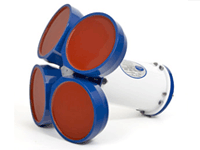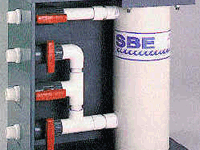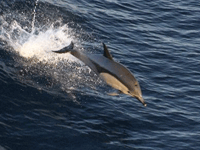Category: Field Work
-

Multi-Frequency Acoustics
A combination of multi-frequency acoustics and midwater trawl samples are used to estimate the biomass and distribution of mesopelagic and epipelagic (sardine and anchovy) fishes as well as macrozooplankon and identify areas of enhanced productivity and concentration in the southern California Current.
-

Acoustic Doppler Current Profiler
ADCP continuous profiles of ocean currents and acoustic backscatter between 20 and 500 meters deep are measured along the shiptrack from a hull-mounted 150 kHz Acoustic Doppler Current Profiler (ADCP). The ADCP data are averaged over 3-minute intervals; typically sixty 8-meter depth bins are recorded. On NOAA vessels, ADCP data collection may be altered by…
-
Advanced Laser Fluorometer
Continuous underway analysis of phytoplankton pigment groups and variable fluorescence (Fv/Fm). ALF, developed by A. Chekalyuk at Lamont-Doherty Earth Observatory, uses laser stimulated emission at 405 and 532 nm together with spectral deconvolution analysis to distinguish fluorescence from three types of phycoerythrin, chlorophyll-a, and chromophoric dissolved organic matter (CDOM). The ALF is useful for differentiating…
-
Underway pCO2
Current interest in ocean acidification has led to development and deployment of an underway pCO2-pH system. Built in the lab of Dr. Todd Martz at Scripps Oceanography for LTER, the system is installed by CALCOFI on our quarterly cruises. The system is comprised of a Sunburst Sensors SuperCO2 system for pCO2, a Durafet III pH…
-

Sea Surface & Meterological Data
All CalCOFI ships actively collect sea surface, meteorological, and other types of continuous data. There are differences in systems used between boats and agencies as well as differences in data types and availability. The core parameters that are most reliably collected are navigational data such as GPS, thermosalinographic and fluorometeric data, and various types of…
-

Bird Observations
Since 1987, seabirds and marine mammals have been surveyed along the CalCOFI transect during daylight hours while the ship is underway. Data counts on seabirds and marine mammals are entered into a handheld computer in real time and are available to filter or download on the Datazoo webpage. Bird observers participating on CalCOFI cruises are…
-

Marine Mammal Observations
In April 2004, a visual and acoustic marine mammal survey component was added to the CalCOFI project to study cetacean ecology and habitat. Visual monitoring is conducted during quarterly cruises by experienced marine mammal observers using handheld 7x binoculars. Supplementary Bigeyes (25x magnification) or image stabilizer hand-held binoculars (18x magnification) are used for species identification…
-

CUFES Fish Egg Survey
The Continuous Underway Fish Egg Sampler (CUFES) is an instrument used to collect pelagic eggs of fish and related hydrographic data from ~3m depth on a moving ship. These samples and data, typically collected during winter and spring cruises, are used to investigate spawning habitat and estimate spawning biomass. When large aggregations of fish eggs are present, Pair-o-vet…
-

RV Reuben Lasker
NOAA Ship Reuben Lasker is the fifth in a series of the most technologically advanced fisheries vessels in the world. The Lasker will primarily support fish, marine mammals and turtle surveys off the U.S. west coast and in the eastem tropical Pacific Ocean. The Lasker arrived to its west coast home port San Diego in…
-

RV Robert Gordon Sproul
RV Robert Gordon Sproul, named for the 11th president of the University of California (1930-1958), is the smallest oceanographic research vessel in the Scripps Instituition of Oceanography fleet. Built in 1981, the 125ft vessel operates with 5 crew and accomodates 12 scientists. Robert Gordon Sproul’s outstanding contribution during his 28-year administration was the multiple-campus expansion…